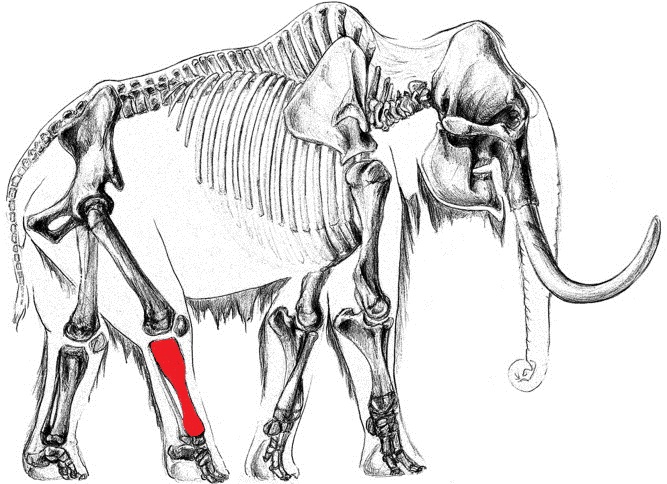"Ice Age Mammal Bones of northwest Alaska" is a new series of blog posts written by NPS archaeologist Jon Hardes. Each post will highlight bones that have been found in the region, often by local residents. If you have found an interesting bone, stop in to share it with Jon at our office in Kotzebue's Northwest Arctic Heritage Center.
See also:
Prehistoric Horse (Equus sp.) maxilla
Short-faced bear (Arctodus simus) mandible

Woolly mammoth (Mammuthus primigenius) tibia

Photo by J. Hardes
Mammoth tibia (lower rear leg bone) discovered near Kotzebue, Alaska. This specimen resides in the collections of LaVonne's Fish Camp. Beyond physical features present on the bone, the sheer size and general shape of the bone helps to identify it as being from a mammoth, as no other terrestrial (land) mammal other than Asian and African Elephants was/is as large.
Identifying Features: The overall length of the tibia measures approximately 80cm (more than 30 inches). The tuberosity is an attachment point for the patella (kneecap). The anterior crest (shin bone) provides an attachment point for the deep connective tissues of the leg. The medial malleolus is a prominence on the medial (outer) side of the ankle that provides attachment points for ligaments.

Illustration of a woolly mammoth skeleton with the right tibia highlighted
A very brief description of the mammoth:
Mammoths first entered North America from Asian and Europe some 1.7 – 1.2 million years ago, after they, along with Asian elephants diverged from African elephants about 4 million years ago. Ultimately, they evolved into about 10 distinct species worldwide, the first of which were described by German scientist Johann Blumenback in 1799.
Though the woolly mammoth has garnered the most attention from popular media in large part due to its size, it was not the largest of the various mammoth species. That distinction goes to the Imperial mammoth (M. imperator) which grew to about 13 feet (a bit taller than the largest male African elephant). The smallest of the mammoths were the Pygmy or Dwarf mammoths (M. exilis) who often only reached 5-6 feet in height. These diminutive mammoths were found isolated on the Channel Islands of California and thought to be descendants of the Columbian mammoth (M. columbi).
Illustration of a woolly mammoth herd by Mauricio Anton
The woolly variety was unique however, with its long, heavily insulated fur (12-35 inches in length) covering its body and its home range in the extreme northern latitudes of the globe. Its habitat also helped with its popularity due to the number of intact frozen specimens discovered which have allowed for accurate reconstructions of its appearance in life. The animal was also commonly featured in prehistoric art.
Woolly mammoths were known to live beyond 60 years of age. They had six sets of molar teeth (each set consisting of 2 on top and 2 on bottom) throughout a lifetime which were replaced five times, with the final set emerging at approximately 30 years of age. Calves developed small "milk tusks" a few centimeters long at six months old, which were replaced by permanent tusks a year later. Tusks (actually elongated incisors) grew at a rate of approximately 2.5-15 cm (1-6 inches) per year. Tusks are comprised of growth rings, that much like tree rings, can be counted in order to determine the age of an individual. Unfused limb bones show that males grew until they reached the age of 40, and females grew until they were 25.
Mammoths were grazers of plant food, focusing primarily on grasses and sedges. An adult would consume nearly 400lbs of vegetation daily.
Woolly mammoths disappeared from mainland North America approximately 10,000 years ago. However, isolated populations survived on Wrangel Island in the Arctic Ocean until less than 4,000 years ago!
Further Information:
National Park Service Paleontology Program
Mammoths and Mastodons: Titans of the Ice Age travelling exhibit
Further Reading:
Ice Age Mammals of North America. Ian Lange. 2002
Mammoths: Giants of the Ice Age. Adrian Lister, et al. 2007
Mammoths, Mastodonts, and Elephants: Biology, Behavior and the Fossil Record. Gary Haynes. 1993
Osteology for the Archaeologist: The American Mastodon and the Woolly Mammoth. Stanley J. Olson. 1979
If you enjoy this blog series on Ice Age Mammal Bones of Northwest Alaska, please leave a comment or question below. We appreciate your feedback.
Were these bones collected within the Western Arctic National Parklands?
No. Removing a mammoth tibia or any other artifacts and palentological resources from federal lands (such as those managed by the National Park Service, Bureau of Land Management, U.S. Fish & Wildlife Service, etc) is not permitted:
The Paleontological Resources Preservation Act (enacted in July 2002)
As these resources are non-renewable, the purpose of this Act is "to establish a comprehensive national policy for preserving and managing paleontological resources on Federal Lands."
"A paleontological resource may NOT be collected from Federal lands without a permit issued under this Act by the Secretary" and resources "collected form Federal lands under the permit will remain the property of the United States."
Damage to paleontological resources can lead to conviction and a class E felony.
Protect Our Nation's Cultural and Natural Resources
1. Please do not touch, move, collect or otherwise disturb artifacts, cultural features, or paleontological resources.
2. Record the site location with a GPS unit or by marking it on a topographic map with compass bearings to prominent landmarks.
3. Provide a detailed description of approximate size, numbers, and position of materials.
4. If you have a camera, please take photographs of the site area and surrounding landscape. If possible, include a scale in photos of individual items or specimens.
5. Report information to:
Park Superintendent or Park Archaeologist/Cultural Resources Manager
PO Box 1029, Kotzebue, AK 99752 Phone: (907) 442-3890

